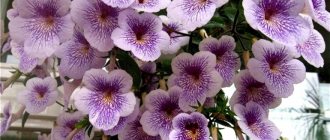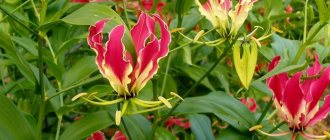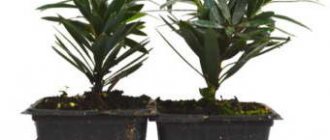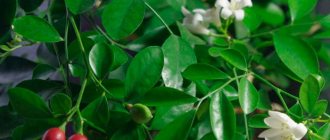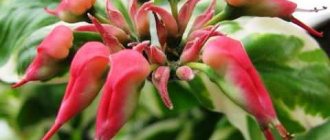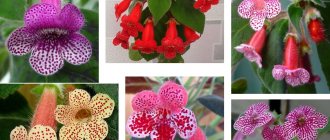At home, the shrub can grow up to 1.5 m in height. Its stems and shoots are highly branched, covered with smooth yellowish-gray bark. The lush green foliage is small and very dense, has an oval shape and a glossy surface. The flowers are small, milky white, collected in paniculate inflorescences. They are shaped like orange flowers. After flowering, juicy red-brown fruits and berries appear on the bushes.
See also how to grow a lemon tree at home.
| Low growth rate. |
| Blooms in summer and autumn. |
| An easy plant to grow. |
| Perennial. |
Features of Muraya
In the wild, paniculata muraya, also called paniculata muraya (Murraya paniculata), is an evergreen shrub or tree, reaching a height of 7 meters, while the trunk is approximately 13 centimeters in diameter. This species also has low-growing forms, the height of which does not exceed 200 cm. The glossy, smooth, odd-pinnate leaf plates are complex, they consist of 3–9 leaflets. The foliage has a pleasant smell. The surface of young foliage has pubescence, while the surface of mature leaves is smooth. Fragrant flowers, up to 20 mm in diameter, can be painted cream or white; they have 5 petals that are bent back. The fruit is a small red berry that is fully ripe approximately four months after emergence. At the same time, blooming flowers, buds, and also berries may be present on the bush. Under natural conditions, this species can be found in Southeast and South Asia, the islands of Java and Sumatra, Northern Australia, Taiwan, India, Malacca, the Philippines, Southern China and the southern part of the USA.
Where does the plant come from?
Muraya's natural habitat is the territory of India, Taiwan, China, Northern Australia, and Japan.
In its natural habitat, Muraya prefers to climb up rocky slopes
Chinese emperors placed a pot with a beautiful flower in their bedroom. They believed that it prolongs their youth and improves their health.
Emperors from the Land of the Rising Sun preferred to enjoy the view of luxurious exotic flowers in their gardens, and forbade their subjects to grow the flower under pain of capital punishment.
For Europe, the plant was discovered by a student of Carl Linnaeus. As a professor of botany and medicine, Andreas Murray described the plant and named it by its own name.
Growing muraya from seeds
It is very easy to grow Muraya from seeds indoors. At the same time, you should know that the seed remains viable for a relatively long time. Before sowing, the seeds should be kept in lukewarm water for 2 hours, then they should be evenly distributed over the surface of a moistened soil mixture, which includes sand and peat (1:1). You can also grow seedlings in peat tablets or a soil mixture consisting of sand and leaf soil. There is no need to bury the seeds in the substrate; they should be covered on top with a thin layer (0.5–1 cm) of soil mixture. The containers need to be covered with glass or film on top, then they are transferred to a well-lit place where there is no direct rays of the sun, and the air temperature should be from 22 to 28 degrees. The first seedlings should appear 30–40 days after sowing, and after they have formed 3 true leaf blades, the plants should be planted in individual pots. Muraya, grown indoors, is distinguished by its undemanding nature.
Muraya from berries. Sowing seeds. Shoots
Murraya paniculata seed sowing technology
Obtaining and preparing Murraya seeds
When the seeds are ripe, it is better not to overexpose them, so as not to start rotting right on the branches, unless they fall off on their own (this has never happened - not once).
We eat or wash the pulp, freeing the seeds. If there are any remaining pulp, carefully peel it off, rinse it in a strainer under running, warm water and place it in a depleted solution of Bordeaux mixture. For me, it becomes depleted due to the constant evaporation of moisture from the glass. I add fresh water; some of the active substance, one way or another, decreases with use. The glass with the solution has been on the shelf in the bathroom for about a year, it has not lost any activity, it just constantly precipitates - you have to stir it when using it.
Depleted solution of Bordeaux mixture - for soaking seeds
Murraya paniculata Russia - seeds in the greenhouse, 06/22/2016
In this example, the seeds were kept in the fungicide for a day (there was simply no time for them). And so, in the evening they are soaked overnight, in the morning they are washed under running water and placed in a greenhouse on moistened foam rubber.
Sowing seeds
So, the seeds are pre-prepared - cleared of pulp, washed under running water and soaked in a solution of Bordeaux mixture or copper sulfate for 2-3 hours, washed again and placed in a greenhouse for pecking the roots. All this is done with the aim of visually rejecting low-quality (underdeveloped, rotten, empty) seeds. And so, you can sow all the seeds at once, without sorting, and hope that out of 10, all 10 will germinate, however, it is not a fact that this will happen. Even viable seeds, for some reason, may not germinate - simply rotting in the ground.
It has been noticed that if the seeds are green, the roots hatch quickly; if the seeds are beige, then it takes a little longer; brown ones are not viable, they are already rotten and not developed. In such seeds, the remainder contains only the outer and inner shells; the embryo itself, as a rule, is no longer there or it has rotted, or was very small.
Seed germination will take place in a greenhouse from a container with a foam rubber insert placed at the bottom, filled with water until this substrate is wetted and water appears on the surface - just barely.
The greenhouse is heated, on a glass shelf, which in turn is in direct contact with the heated towel rail. Heating temperature is about 32-35°C. I note that for seeds; Murraya, citrus fruits, tomato, pepper, pomegranate, fig, kiwi, etc. such a high heating temperature is quite acceptable and works well. It has been noticed that root pecking occurs even faster if you remove the greenhouses from heating at night and leave them there, in the bathroom. The sown seeds, with the roots sprouted, can be placed in a room with a temperature of 26-28°C, under cover in the form of a greenhouse made from an inverted cup, until the sprout hatches. At lower temperatures (below 24°C), sprouts appear a little later.
Murraya paniculata, heated greenhouse, 06/24/2016
Murraya paniculata Russia - roots hatched, 05.24.2016
Murraya paniculata Russia - seedlings, 05.25.2016
By the way, for Japanese medlar seeds, this temperature turned out to be too high. After more than 1.5 months of being heated, not one of them pecked a root. As soon as the hot water supply was turned off and the greenhouses moved to a room with an air temperature of 28-30°C, the roots immediately began to peck. Almost all the seeds have already been planted in individual cups, with shelter from an inverted cup, in the form of a greenhouse - so that the soil does not need to be watered until shoots appear and the shelter is removed.
Planting seeds in the ground
The roots peck in different ways, usually in 3-4 days, up to 7 days. I plant them in plastic cups with a volume of 100-200 ml, at the bottom they have four crosswise cuts (drainage holes). The cups are filled with a self-prepared soil mixture of the approximate composition that is prepared for citrus fruits. The soil is watered until completely wet. This cup is inserted into a similar one, but without slots, or installed in a common tray (wide, large tray).
After planting in 100-200 gram cups and placing them under backlight lamps, the cups are covered with caps. Thus, a greenhouse is created from inverted cups of the appropriate size. Constant humidity is maintained in the greenhouse, which promotes faster seed germination and release from the outer shell. Also, the soil does not require additional watering and moistening, since its moisture is maintained in the greenhouse.
Date of planting, pecked seed root, in 100 g glass
Murraya paniculata (Russia) first shoots 06/04/2016
Murraya paniculata - installation of seedlings under lamps
In order not to accidentally injure a young root, a small depression is made in the moistened soil (with a metal nail file) - the seed is inserted without any effort, slightly buried relative to the ground level and with a nail file, the soil is compressed around the planted seed.
By the way, to plant citrus fruits, in 200 ml cups, I puncture the soil with the same nail file, almost to the very bottom. To plant medlar seeds, shaking the stuck nail file back and forth, I widen the hole. In principle, if you don’t bother, the seeds can easily be stuck into soil that has just been moistened and is still quite loose in the top layer.
Caring for Muraya at home
Illumination
The room in which the flower is located must be systematically ventilated. The lighting should be diffused, but the bush can be in direct sunlight for 2 to 3 hours a day. In winter, you need to make sure that the muraya has enough light. Experts advise placing a flower near a window located in the eastern or western part of the room.
Temperature
In spring, summer and autumn, this plant needs warmth (from 24 to 28 degrees), and in winter the temperature in the room should be reduced to 17–20 degrees, because Muraya has a weak rest period.
Trimming
There is no need to trim or pinch the bush, since the plant is able to form its own crown on its own. However, in rare cases it may be necessary to shorten an overly long shoot. In order for the bush to have a beautiful shape, it must be systematically rotated along with the container around its axis.
How to water
In spring and summer, Muraya will need to be provided with abundant, but not frequent watering. At the same time, you need to water the bush only after the lump of earth has dried out by 1/3. Water is used without chlorine and soft (it is mixed with a small amount of citric acid). In autumn and winter, watering should be reduced, but the rules remain unchanged, namely, the bush should be watered only after the earthen ball has dried out by 1/3.
Air humidity
The air humidity in a city apartment is quite suitable for this flower, so it does not need to be moistened with a spray bottle every day. But you still need to spray the plants from time to time, especially on hot days.
Fertilizer
In spring and summer, Muraya needs systematic feeding: once every 15–20 days. In spring, the flower needs potassium and nitrogen, which promotes more active growth of green mass. It is recommended to use organic and mineral fertilizers alternately for fertilizing, but try not to overfeed the flower. In autumn and winter, fertilizers cannot be added to the soil mixture.
Transplanting muraya
Young specimens are transplanted every year. Adult plants are replanted once every 2 or 3 years, but every year in spring, experts advise replacing the top layer of soil mixture in pots. The pot should be chosen so that it is not too small or too large. The soil mixture must be loose and rich in nutrients. For example, to create it, you can combine turf and leaf soil, humus and sand in a ratio of 2:2:1:2. Muraya can also be transplanted into a ready-made soil mixture for citrus fruits. Don't forget to make a good thick drainage layer at the bottom of the container before planting. Transplantation is carried out using the transshipment method, while trying to ensure that the earthen lump does not collapse.
Bloom
During flowering, the bush opens a large number of pale cream or white fragrant flowers, reaching 20 mm in diameter. Blooming muraya is very spectacular and can become the main decoration of any room, especially considering that the flowering period is approximately 6 months (in some cases it lasts longer).
No flowering
Some gardeners complain that their muraya bush does not want to bloom. This may be due to various reasons. So, if Dutch muraya is grown, then you need to remember that from the moment of purchase to the first flowering it can take from 3 to 4 years. Also, the bush may not bloom because it is grown in an excessively cramped container; as a rule, after transplanting into a larger pot, the bush soon begins to bloom.
How can muraya be harmful?
Having so many beneficial qualities and properties, muraya may still have contraindications for its use as a medicine. Before use, you should still consult a doctor. Fruits and tinctures can lower blood pressure. Those who have low levels should consult a specialist before using the medicine.
Additional therapeutic effects of medicinal products from the plant for various diseases
Several times a day, muraya infusion is used to treat a sore throat by gargling with an infusion of leaves. Pour 5-7 leaves with strong boiling water and allow 15-20 minutes to brew. This tincture also helps with heart ailments. For those who have had a heart attack, it is recommended to make an alcohol tincture: 5 tbsp. l. fruits and leaves of muraya, pour in 250 milliliters of vodka or alcohol, let it brew in a dark place. Before meals, take 30 drops daily. For severe dermatitis, compresses are made using muraya, rosemary and plantain. A bandage is applied to the inflamed areas of the skin.
Take 3 tbsp. l. leaves of each type of plant and the same amount of fruits, pour boiling water and infuse. For diabetes, muraya berries are very useful; they reduce blood sugar levels. When you are tired after hard work, berries can add vigor and strength. Other uses of the plant in everyday life.
Reproduction of Muraya
Muraya can be propagated by seeds. How to do this is described in great detail above. This plant can also be propagated by cuttings, but it should be noted that this method is unreliable. Semi-lignified cuttings are cut from one-year-old shoots. For rooting, cuttings should be planted in wet sand, perlite, peat, or they can be placed in a glass of water. The cuttings need warmth (from 26 to 30 degrees); they must be covered on top with a transparent polyethylene cap or glass jar. It will be very good if the cuttings are provided with bottom heating.
Muraya can be propagated by cuttings in September–November. Rooted cuttings need to be transplanted into individual pots filled with fertile, loose soil mixture, and a good drainage layer must be made at the bottom.
Diseases and pests of muraya
If the muraya does not have enough light, as well as with excessively low air humidity or improper watering, problems may begin with it. For example, a fungal disease may develop on a bush, or spider mites or scale insects may settle on it and feed by sucking cell sap from various parts of the plant. To destroy pests, muraya needs to be treated twice or three times with an acaricide solution (Karbofos or Actellik), and an interval of 7 days must be maintained between sessions. If the bush is affected by a fungal disease, then it must be sprayed with a fungicide solution (Fitosporin-M, Fundazol, Oksikhom or another drug with a similar effect). However, in order to cure a plant, it is very important to begin to properly care for it, as well as create optimal conditions for its growth and development.
Muraya leaves turn yellow: what to do
Leaves may turn yellow if the soil is highly alkaline or lacks beneficial microelements. The plant also sheds its leaves due to a sharp change in temperature, natural aging, lack of sufficient watering, excessive oversaturation of fertilizers, and improper care. A plant can turn yellow, fall and shed its leaves due to improper transplantation, for example, into a pot that is too spacious. Yellowing of the leaves may be due to chlorosis (a common disease of shrubs).
To prevent the plant from getting sick, you need to provide moderate watering with settled water, monitor useful additives for the absence of chlorine in the composition.
In general, an exotic citrus plant can decorate any room with its appearance. It is not difficult to care for, the main thing is to plant it in a large pot, water it on time and take preventive measures against diseases, otherwise it may shed its beautiful leaves and flowers.
Types and varieties of muraya
It was already mentioned above that indoor gardeners cultivate only varieties of Muraya paniculata, for example:
- Min-a-min . This variety is a compact form of the Smart Choice garden variety. The height of this bushy plant is about 100 cm and is characterized by rapid growth. In regions with a mild, warm climate, this variety can also be grown in the garden, creating magnificent hedges.
- Minima . The height of such a miniature plant is from 0.4 to 0.6 m, it is characterized by slow growth, and its flowering begins already in the first year of life. This variety is excellent for growing indoors.
- Dwarf Compact . This is a dwarf variety, the height of the bush does not exceed 10–15 centimeters, the length of the oval leaf blades is about 0.5 cm. This variety is considered the most demanding in terms of care and growing conditions.
You can sometimes find advertisements that offer to purchase Dutch muraya. But this is just Muraya paniculata, which was brought from Holland for sale.
Caring for Muraya at home
Murraya species
More than a dozen species of Murraya grow in nature. However, only a few of them are grown indoors.
Murraya exotic Myrraya Exitica
This exotic beauty is valued for its glossy leaves of rich emerald color. If they are touched, the flower will begin to exude a tart aroma, similar to the fragrance of rue. The plant is common in some Asian countries: India, Sumatra, China. Outwardly, it is very similar to lemon, so they are often confused.
A botanist from Germany in the 18th century, Murray, first described the plant; it was to him that it owes its name, although it would be more correct to call it Murray.
The growth period of an exotic species is long. Murraya Exotica first accumulates nutrients, after which it begins to grow rapidly.
Inflorescences develop within three weeks. They are self-pollinating and look like lemon buds. Despite the small volumes of the shrub, the flowers reach large sizes.
Eastern legend says that in ancient times, muraya was grown exclusively in the palaces of emperors.
You can brew aromatic tea from the fruits, inflorescences and leaves, which has beneficial properties. There is a small seed inside the fruits, and they themselves are completely edible.
Murraya Paniculata
Paniculata is often called Japanese myrtle. This is because the old origin is Japan. It is also called fragrant muraya.
It was considered a magical tree that brought wealth, luck, health and longevity.
The stems of the plant are covered with elliptical leaves. They are dense and glossy. The shoots themselves are flexible, and in this parameter they are not inferior to weeping willow.
The growth period of paniculata is stormy. It is actively developing in height and width. The stems are thin and fragile, so they should be tied up. Otherwise the shoots will break.
Previously, it was strictly forbidden for mere mortals to have such a plant in their home; it was punishable by death.
In the cold season, pots with paniculata should be moved to a warm place and bright lamps should be turned on regularly.
During the flowering period, lush, fragrant caps of inflorescences cover the entire bush. Even a small bud fills the room with a unique aroma and improves the atmosphere.
Muraya is considered a plant that stops aging and gives good health to its owners.
Unlike other varieties, paniculata murraya begins flowering eight years after planting.
Dwarf
This type is most popular among lovers of exotic indoor flowers. This is a compact, miniature bush, reaching 70 cm.
It blooms already in the first half of its life. Blooms all year round, even in winter. At the top of the stems, new buds are simultaneously formed, old ones bloom, and fruits are formed - this process is not interrupted for a single month.
It reproduces by self-pollination, and the berries ripen in three months.
Non-fruiting varieties
There is a variety of Murraya that does not produce fruit. She was bred by a breeder from Australia. It is used mainly when decorating local areas and landscaping streets. With the help of pruning, shrubs are given various shapes and original green sculptures are created, which are used to decorate parks or public gardens.
Only emperors were allowed to inhale the miraculous aroma in order to preserve health, beauty, intelligence and give birth to children with unique abilities.
Properties of muraya: harm and benefit
Medicinal properties of muraya
Already in Ancient Egypt they knew that muraya had medicinal properties. There are many myths about this plant, and the history of its origin is shrouded in mystery. But what is the use of this plant, called the “tree of Japanese emperors”? The foliage contains hesperidin - this bitter glycoside affects capillary permeability. This plant also has an anti-inflammatory, strengthening and wound-healing effect, so it is used in alternative medicine for gastritis, diarrhea, dysentery and other diseases of the gastrointestinal tract, as well as for various wounds. The leaves are also used externally for pain and aching joints. And the juice obtained from the leaves effectively eliminates headaches and toothaches. The berries of this crop contain biologically active substances, namely: antioxidants and vitamins. If you eat 3 or 4 of these fruits per day, this will be an excellent prevention of premature aging. They are also used for coronary heart disease, hypertension and other diseases of the cardiovascular system. They are also indicated for diabetes mellitus, because they help reduce blood sugar without the use of medications.
Making a muraya tincture is very simple; to do this, you need to take the berries and leaves in equal weight proportions. To begin with, the seeds are removed from the berries, then they and the leaves are crushed. The resulting mass is poured into a glass vessel into which vodka is poured, adding 2-3 tbsp. l. the mixture takes 0.25 liters of vodka. The tightly sealed vessel is placed in a cool and dark place for 15 days, and the liquid must be shaken systematically. The finished tincture is taken 20–30 drops twice or thrice a day for 30 minutes. before the meal. It helps with heart failure, coronary heart disease, frequent migraines and as a preventive measure against myocardial infarction.
Murraya: description
Muraya is a bright representative of the Rutaceae family, belonging to both trees and shrubs. You can see it in India and Central Africa. Has many varieties. Care is simple if planted correctly and temperature, lighting and watering are observed.
Muraya flower
Origin and appearance of the Muraya plant
It is a shrub related to lemon and tangerine. The plant was first discovered in the 18th century. Swedish naturalists in the Himalaya region. It is named after Murray, the scientist who found the first specimen.
For your information! Muraya is a heat-loving plant and can be seen in its natural habitat in Sumatra and Taiwan. It also grows in China, India and Nepal. In addition, there are on the Australian continent.
The appearance cannot leave anyone indifferent: a two-meter green plant with thin trunks covered with brown bark, with shiny smooth leaves. Each leaf contains buds, which in spring turn into snow-white, five-leaved flowers with jasmine-scented, upturned ends. At the end of spring, red muraya fruits covered with an orange peel appear from the flowers. Inside each there is a yellow seed.
Japanese Emperors Tree
Muraya is called the tree of the Japanese emperors because the leaves and flowers of the plant have been used for medicinal purposes since the beginning of the empire in Japan. Every muraya leaf is useful. From them they prepared tinctures with decoctions, which only representatives of the Japanese dynasty were allowed to drink to increase the hidden qualities of a person. The imperial drink improved sexual energy and male power. Attempts to take the seed home and try to grow Murraya at home ended in cutting off the head.
plant flower
Muraya is an indoor flower. The buds of the plant have a snow-white or milky hue. Appear in quantities of 10 to 15 pieces. and grow in clusters. The diameter of the flowers is 2 cm. Inside each there are yellow stamens, the aroma of which is reminiscent of jasmine flowers.
Appearance of the flower
